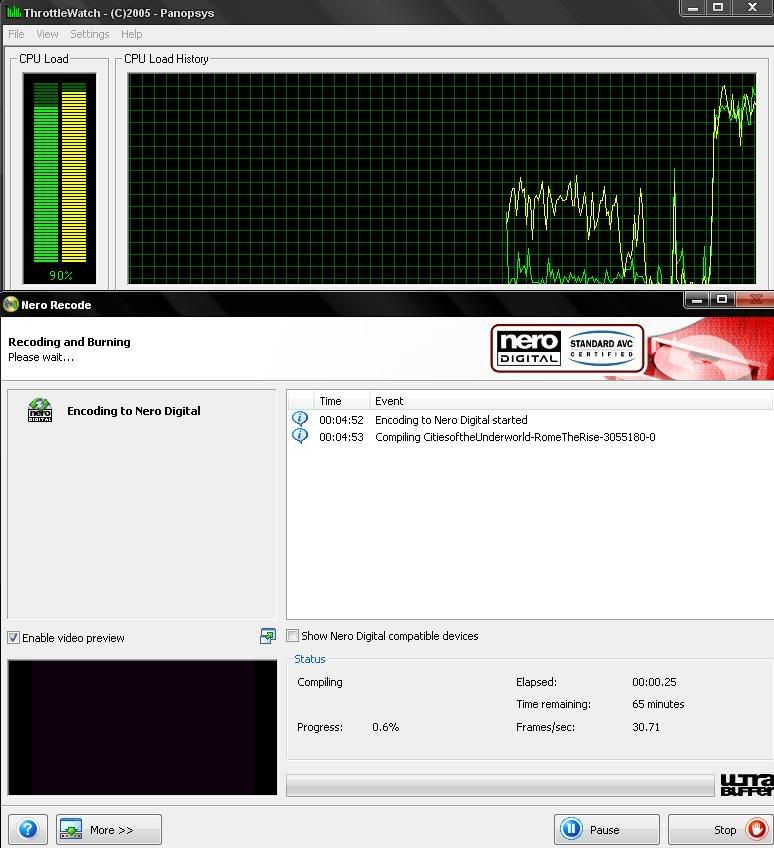Good question. Most people believe that a higher FSB and lower multiplier are better since this maximizes the bandwidth on the FSB. Or is a low bus rate and higher multiplier better? Or is there no difference? I looked at three different settings on my Q6600:
9x333 = 3.0 GHz (DRAM was 667 MHz)
8x375 = 3.0 GHz (DRAM was 750 MHz)
7x428 = 3.0 GHz (DRAM was 856 MHz)
The DRAM:CPU ratio was 1:1 for each test and the voltage and timings were held constant; voltage was 2.25V and timings were 4-4-4-12-4-20-10-10-10-11.
After the same experiments, at each of these settings, I concluded that there is no difference for real world applications. If you use a synthetic benchmark, like Sandra, you will see faster memory reads/writes, etc. with the higher FSB values -- so what. These high FSB settings are great if all you do with your machine is run synthetic benchmarks. But the higher FSB values come at the cost of higher voltages for the board which equate to higher temps.
I think that FSB bandwidth is simply not the bottle neck in a modern system... at least when starting at 333. Perhaps you would see a difference if starting slower. In other words, a 333 MHz FSB quad pumped to 1333 MHz is more than sufficient for today’s applications; when I increased it to 375 MHz (1500 MHz quad pumped) I saw no real-world change; same result when I pushed it up to 428 MHz (1712 MHz quad pumped). Don’t believe me? Read this thread wherein x264.exe (a video encoder) is used at different FSB and multiplier values. Have a close look at the 3rd table in that thread and note the FPS (frames per second) numbers are nearly identical for a chip clocked at the same clockrate with different FSB speeds. This was found to be true of C2Q as well as C2D chips.
You can do a similar test for yourself with applications you commonly use on your machine. Time them with a stop watch if the application doesn’t report its own benchmarks like x264 does.
Some "Real-World" Application Based Tests
Three different 3.0 GHz settings on a Q6600 system were tested with some apps including: lameenc, super pi, x264, winrar, and the trial version of photoshop. Here are the details:
Test O/C 1: 9x333 = 3.0 GHz

Test O/C 2: 8x375 = 3.0 GHz

Test O/C 3: 7x428 = 3.0 GHz

Result: I could not measure a difference between a FSB of 333 MHz, 375 MHz, or 428 MHz using these application based, "real-world" benchmarks.
Since 428 MHz is about 28 % faster than 333 MHz, you’d think that if the FSB was indeed the bottle neck, the higher values would have given faster results. I believe that the bottleneck for most apps is the hard drive.
Description of Experiments and Raw Data
Lame version 3.97 – Encoded the same test file (about 60 MB wav) with these commandline options:
Code: Select all
lame -V 2 --vbr-new test.wavSuper Pi version 1.1 – Ran both the 1M and 2M tests and compared the reported total number of seconds to calculate as the benchmark.
x264 version 0.54.620 – Ran a 2-pass encode on the same MPEG-2 (480x480 DVD source) file twice and averaged the FPS1 and FPS2 numbers as the benchmark. In case you’re wondering, here is the commandline options for this encode, pass1:
Code: Select all
x264 --pass 1 --bitrate 1000 --stats "C:\work\test-NEW.stats" --bframes 3 --b-pyramid --direct auto --subme 1 --analyse none --vbv-maxrate 25000 --me dia --merange 12 --threads auto --thread-input --progress --no-psnr --no-ssim --output NUL "C:\work\test-NEW.avs"Code: Select all
x264 --pass 2 --bitrate 1000 --stats "C:\work\test-NEW.stats" --ref 3 --bframes 3 --b-pyramid --weightb --direct auto --subme 6 --trellis 1 --analyse all --8x8dct --vbv-maxrate 25000 --me umh --merange 12 --threads auto --thread-input --progress --no-psnr --no-ssim --output "C:\work\test-NEW.264" "C:\work\test-NEW.avs"Code: Select all
global MeGUI_darx = 4
global MeGUI_dary = 3
DGDecode_mpeg2source("C:\work\test-new.d2v")
AssumeTFF()
Telecide(guide=1,post=2,vthresh=35) # IVTC
Decimate(quality=3) # remove dup. frames
crop( 2, 0, -10, -4)
Spline36Resize(640,480) # Spline36 (Neutral)Code: Select all
rar a -u -m0 -md2048 -v51200 -rv5 -msjpg;mp3;tif;avi;zip;rar;gpg;jpg "e:\Backups\Backup.rar" @list.txtTrial of Photoshop CS3 – I used the batch function in PSCS3 to batch bicubic resize 10.1 MP to 0.7 MP (3872x2592 --> 1024x685), then applied an unsharpen mask (60 %, 0.8 px radius, threshold 12), and finally saved as quality 8 jpg. In total, 57 jpg files were used in the batch. I timed how long it took to complete two runs, and averaged them together as the benchmark.
Here are the raw data if you care to see them:

I just read the FSB1333 Intel Processors & New 2007 CPU Charts article over at TH.com and am happy to see that the testers over there have drawn the same conclusion that I have about fixed final core speeds with higher and higher FSB speeds: faster FSB speeds w/ a C2Q/C2D don't equate to faster real-world benchmarks.
Have a look at page 8 from their article comparing the "old" 1066 MHz FSB to the "new" 1333 MHz FSB chips: average gain <1 %.






